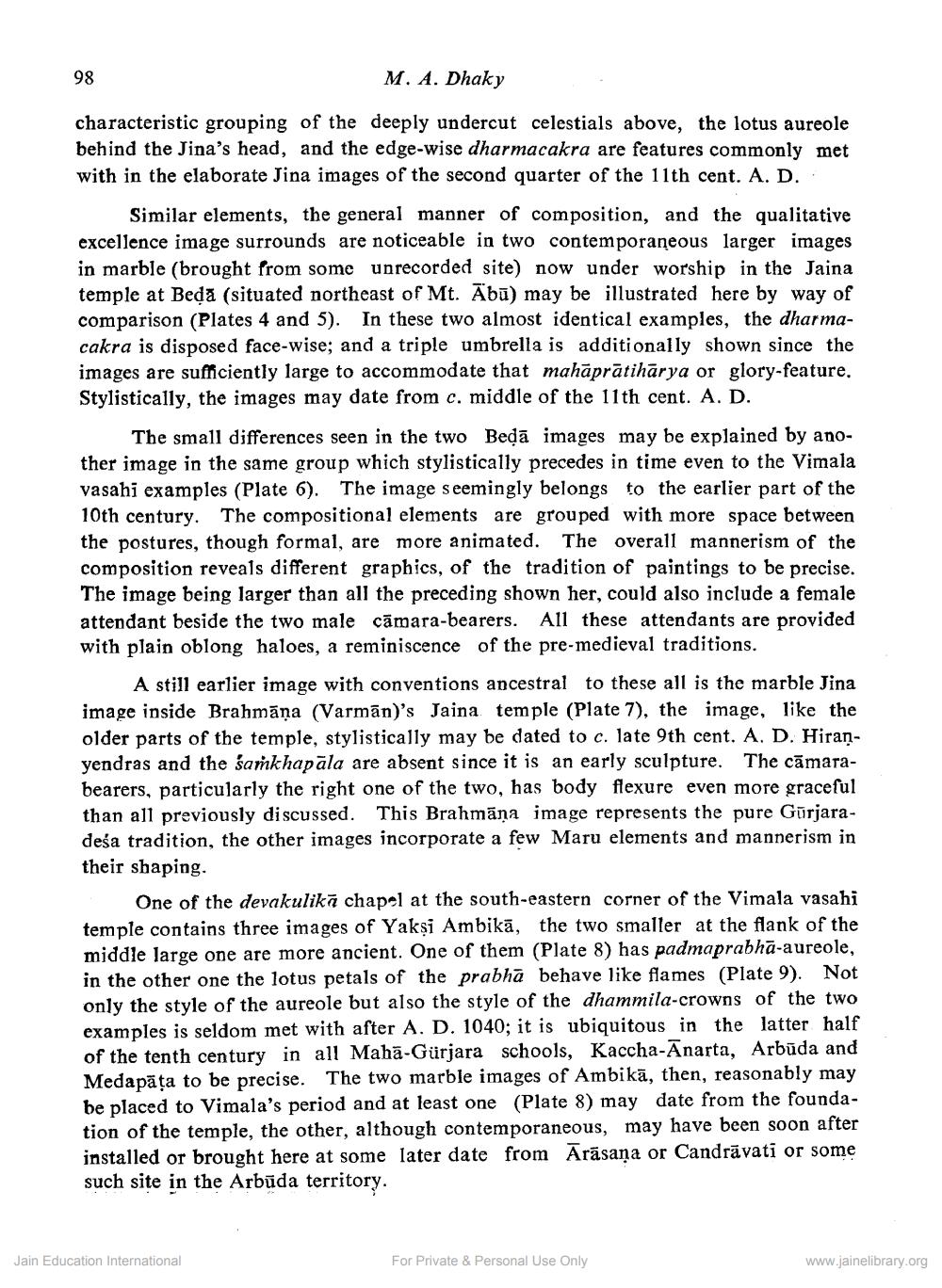Book Title: Vimala Period Sculptures in Vimal Vashi Author(s): M A Dhaky Publisher: Z_Aspect_of_Jainology_Part_2_Pundit_Bechardas_Doshi_012016.pdf View full book textPage 3
________________ 98 M. A. Dhaky characteristic grouping of the deeply undercut celestials above, the lotus aureole behind the Jina's head, and the edge-wise dharmacakra are features commonly met with in the elaborate Jina images of the second quarter of the 11th cent. A. D.. Similar elements, the general manner of composition, and the qualitative excellence image surrounds are noticeable in two contemporaneous larger images in marble (brought from some unrecorded site) now under worship in the Jaina temple at Beda (situated northeast of Mt. Abū) may be illustrated here by way of comparison (Plates 4 and 5). In these two almost identical examples, the dharmacakra is disposed face-wise; and a triple umbrella is additionally shown since the images are sufficiently large to accommodate that mahāprātihārya or glory-feature. Stylistically, the images may date from c. middle of the 11th cent. A. D. The small differences seen in the two Beļā images may be explained by another image in the same group which stylistically precedes in time even to the Vimala vasahi examples (Plate 6). The image seemingly belongs to the earlier part of the 10th century. The compositional elements are grouped with more space between the postures, though formal, are more animated. The overall mannerism of the composition reveals different graphics, of the tradition of paintings to be precise. The image being larger than all the preceding shown her, could also include a female attendant beside the two male câmara-bearers. All these attendants are provided with plain oblong haloes, a reminiscence of the pre-medieval traditions. A still earlier image with conventions ancestral to these all is the marble Jina image inside Brahmāņa (Varman)'s Jaina temple (Plate 7), the image, like the older parts of the temple, stylistically may be dated to c. late 9th cent. A. D. Hiranyendras and the sakhapāla are absent since it is an early sculpture. The cāmarabearers, particularly the right one of the two, has body flexure even more graceful than all previously discussed. This Brahmāņa image represents the pure Gurjaradeśa tradition, the other images incorporate a few Maru elements and mannerism in their shaping. One of the devakulikā chapel at the south-eastern corner of the Vimala vasahi temple contains three images of Yakşi Ambikā, the two smaller at the flank of the middle large one are more ancient. One of them (Plate 8) has padmaprabhā-aureole, in the other one the lotus petals of the prabhā behave like flames (Plate 9). Not only the style of the aureole but also the style of the dhammila-crowns of the two examples is seldom met with after A. D. 1040; it is ubiquitous in the latter half of the tenth century in all Mahā-Gürjara schools, Kaccha-Ānarta, Arbūda and Medapāta to be precise. The two marble images of Ambikā, then, reasonably may be placed to Vimala's period and at least one (Plate 8) may date from the foundation of the temple, the other, although contemporaneous, may have been soon after installed or brought here at some later date from Ārāsaņa or Candrāvati or some such site in the Arbūda territory. Jain Education International For Private & Personal Use Only www.jainelibrary.orgPage Navigation
1 2 3 4 5 6 7 8 9 10 11 12
